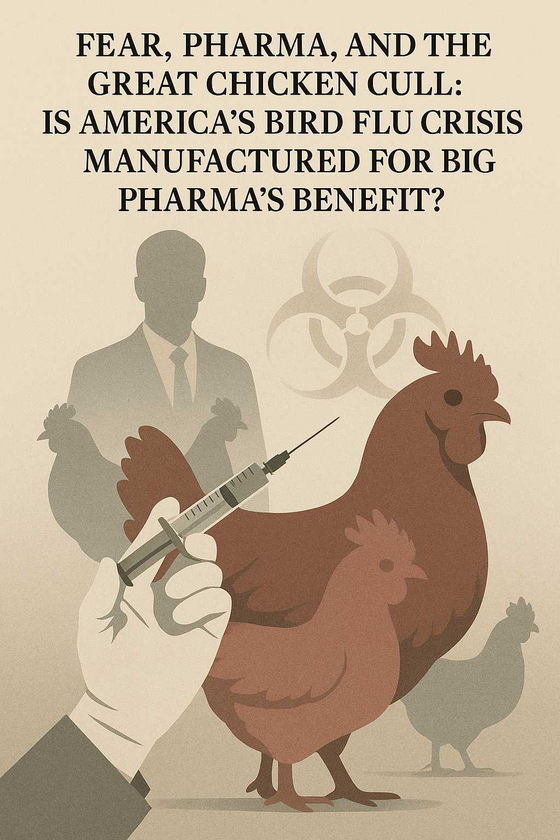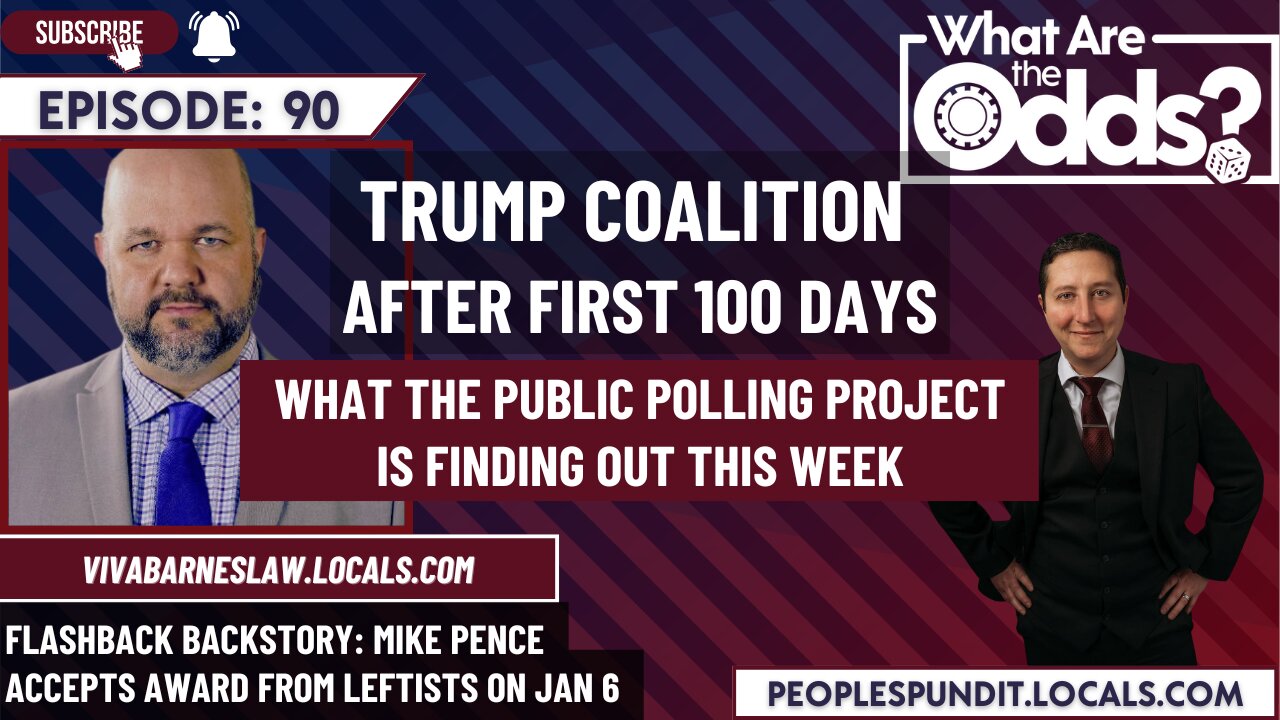Fear, Pharma, and the Great Chicken Cull: Is America’s Bird Flu Crisis Manufactured for Big Pharma’s Benefit?
When someone recently challenged my views on Big Pharma's involvement in the mass chicken culls across America—suggesting I was "grasping at straws"—my first instinct was to fire off a snarky retort. But then I realized something critical: the confusion, skepticism, and misunderstandings around the bird flu crisis aren't entirely their fault. The mainstream narrative has been carefully shaped to make us think millions of birds are sick and dying of avian flu, creating a convenient justification for an expensive new generation of vaccines.
But here's the kicker: those millions of chickens we keep hearing about? Most weren’t even sick—they were culled merely because they were deemed "at risk." It’s essential to unpack why this matters, who's benefiting, and what deeper game may be at play.
Millions of Healthy Birds Culled—Not Sick, Just “At Risk”
Since early 2022, more than 150 million domestic birds—mostly chickens—have been killed in America under the banner of fighting Highly Pathogenic Avian Influenza (HPAI), specifically the H5N1 strain. At first glance, you’d think these birds were dropping dead everywhere, but dig just beneath the headlines and you discover something astonishing:
The vast majority of these chickens were not sick.
According to the USDA’s own guidelines, entire flocks are culled as soon as even one bird tests positive or shows potential exposure. That’s right—these aren’t outbreaks where thousands of birds are keeling over from illness. These birds are systematically euthanized by the tens of millions, not because they're infected, but because they might become infected.
Why such drastic action for hypothetical risk? Officials argue it’s about containment, trade policy, and biosecurity. But consider this: wild birds carry and spread H5N1 freely—meaning mass culling domestic flocks does nothing to stop the virus from continually re-entering farms. Nature can't be locked down, yet our policy response pretends otherwise.
So why persist with a failing strategy? Because each mass culling fuels headlines screaming "Millions of Birds Dead from Avian Flu!"—which terrifies the public and frames H5N1 as the new existential threat.
From Fear to Pharma: Connecting the Dots
This "manufactured urgency" conveniently coincides with major pharmaceutical moves. Let's break it down:
-
2022–2025 saw unprecedented investment in mRNA flu vaccines. Fresh off massive COVID profits, pharma giants—including Moderna, Pfizer, and GSK—jumped into rapid vaccine development against H5N1, leveraging technology first proven profitable during COVID-19.
-
Government contracts exploded: BARDA, the U.S. Biomedical Advanced Research and Development Authority, committed eye-watering sums—like the January 2025 \$590 million deal with Moderna—to speed up development and testing of mRNA vaccines tailored specifically to H5N1.
-
Perfect timing: These lucrative contracts happened precisely as the poultry culling narrative hit fever pitch in mainstream media. Public fear reached critical mass just as Big Pharma was conveniently positioned with next-generation mRNA solutions.
It’s crucial to understand: without the "millions of birds dead" narrative, selling another massive vaccine rollout—especially mRNA-based, after growing skepticism post-COVID—would be far more difficult. The frightening headlines aren’t incidental; they serve the financial and strategic interests of powerful pharmaceutical actors.
Manufacturing Crisis to Sell the Cure
We saw this clearly during COVID: create urgency, manufacture fear, introduce new technology (mRNA vaccines), reap astronomical profits. Is history repeating itself?
The scale of bird flu culls—more than 150 million chickens destroyed—not only justifies the rapid expansion of vaccine programs, but subtly convinces the public that we need these vaccines, or else disaster looms. Forget the inconvenient truth that most culled birds were perfectly healthy, or that wild birds perpetually reintroduce the virus anyway. Instead, headlines push the narrative: “Deadly bird flu ravages poultry industry,” framing mRNA vaccines as our only salvation.
Critics often point out that mRNA technology enables rapid production, bypassing traditional egg-based flu vaccines—conveniently helpful, since the egg industry itself is disrupted by these mass cullings. And here's another convenient alignment of interests: as millions of laying hens are euthanized, egg prices skyrocket, creating economic panic that further pressures policy-makers to act swiftly and aggressively—more vaccines, more funding, more urgency.
Why Ignore Natural Immunity? Because There’s No Money in It
There’s another critical aspect almost entirely ignored in mainstream discussions: natural herd immunity. Epidemiologists have long known viruses naturally attenuate as they circulate. Birds and other animals exposed to pathogens naturally develop immunity—if allowed to survive.
Yet, current USDA policies explicitly deny this natural process. Instead, healthy chickens get culled by the millions, eliminating the very possibility of developing robust herd immunity. Why prevent natural immunity from taking hold? Perhaps because you can't patent natural immunity. You can't charge governments hundreds of millions for it. Big Pharma makes no profit from naturally immune flocks.
As the outspoken skeptic Robert F. Kennedy Jr. has highlighted, allowing birds to survive, reproduce, and naturally build immunity would threaten Big Pharma’s business model. This isn't just speculation: it’s basic economics.
Follow the Money: A Pattern Emerges
Consider these connections carefully:
- BARDA pours millions into Moderna’s mRNA vaccine precisely as the poultry culling hits peak media attention.
- Moderna, Pfizer, and GSK invest heavily in H5N1 mRNA vaccines, aligning with government funding streams.
- Media narratives and public health messaging amplify fear, citing mass poultry deaths as justification for urgent vaccine production.
To deny a financial motive here is naive. Does that mean every veterinarian or public health official is in on a conspiracy? Absolutely not. Most are sincerely trying to control disease outbreaks as they've been taught: rapidly and aggressively. But the bigger strategic direction—the choice to aggressively cull healthy flocks rather than manage outbreaks and encourage natural immunity—is heavily influenced by vested pharmaceutical interests.
A Wake-Up Call: Transparency, Science, and the Public Good
It’s time for a serious reexamination. The current poultry culling policy—destroying millions of healthy birds at the faintest hint of exposure—is neither sustainable nor logical. Wild birds will keep bringing the virus back; mass culling solves nothing long-term. Natural immunity, selective breeding, and targeted vaccinations could provide far better results without devastating animal welfare, consumer prices, and food supply chains.
But a truly sustainable solution—especially one emphasizing natural immunity or limited vaccination—would threaten the pharmaceutical industry's lucrative push toward widespread mRNA vaccine adoption. And that conflict explains why alternatives are rarely seriously considered.
Looking Ahead: A Call to Question Everything
Here’s my optimistic take: recognizing the connections between fear, policy, and profit allows us all to become smarter consumers of news and policy. We don’t need endless cycles of mass animal culling and costly vaccine rollouts built on manufactured crises. Instead, we should demand transparency about the real risks, genuine consideration of natural solutions, and policies driven by science and public benefit—not profits and panic.
Let's use this knowledge as power—power to question, to demand accountability, and ultimately, to build a better, smarter system that works for animals, farmers, and people alike, not just Big Pharma’s bottom line.
Keep asking questions. Keep digging deeper. It’s the only way forward.
Here is the same article on X, please share! https://x.com/AgentGuru_io/status/1923349840022380787





















